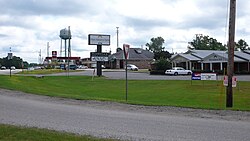Woodstock | |
|---|---|
| Town of Woodstock [1] | |
 Business at the commercial center of Woodstock | |
 Location of Woodstock in Bibb County and Tuscaloosa County, Alabama. | |
| Coordinates: 33°15′15″N87°08′09″W / 33.25417°N 87.13583°W [2] | |
| Country | United States |
| State | Alabama |
| County | Bibb |
| Area | |
• Total | 7.23 sq mi (18.72 km2) |
| • Land | 7.08 sq mi (18.34 km2) |
| • Water | 0.15 sq mi (0.38 km2) |
| Elevation | 577 ft (176 m) |
| Population (2020) | |
• Total | 1,472 |
| • Density | 207.8/sq mi (80.25/km2) |
| Time zone | UTC-6 (Central (CST)) |
| • Summer (DST) | UTC-5 (CDT) |
| ZIP code | 35188 |
| Area codes | 205, 659 |
| FIPS code | 01-83640 |
| GNIS feature ID | 2406913 [2] |
| Website | www |
Woodstock is a town in Bibb and Tuscaloosa counties in the U.S. state of Alabama. Formerly known as North Bibb, by referendum in August 2000, the town adopted the name of a long-established local unincorporated community and, as of October 1, 2000, is now known officially as "Woodstock". As of the 2010 census, the population of the town was 1,428. [4]
Contents
The Bibb County portion of Woodstock is part of the Birmingham metropolitan area, while the Tuscaloosa County portion is part of the Tuscaloosa metropolitan area.

